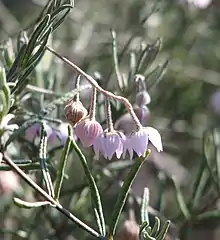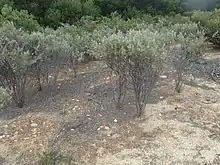| Guichenotia ledifolia | |
|---|---|
 | |
| Scientific classification | |
| Kingdom: | Plantae |
| Clade: | Tracheophytes |
| Clade: | Angiosperms |
| Clade: | Eudicots |
| Clade: | Rosids |
| Order: | Malvales |
| Family: | Malvaceae |
| Genus: | Guichenotia |
| Species: | G. ledifolia |
| Binomial name | |
| Guichenotia ledifolia | |

Guichenotia ledifolia is a species of flowering plant in the family Malvaceae and is endemic to the southwest of Western Australia. It is a densely-branched shrub with densely hairy new growth, hairy, linear to oblong leaves and pink to mauve flowers arranged in groups of three to ten.
Description
Guichenotia ledifolia is a densely-branched shrub that typically grows to 0.5–2 m (1 ft 8 in – 6 ft 7 in) high and 1.0–1.5 m (3 ft 3 in – 4 ft 11 in) wide, its new growth densely covered with white, star-shaped hairs. The leaves are linear to oblong, 15–60 mm (0.59–2.36 in) long and 2–5 mm (0.079–0.197 in) wide on a short petiole with leaf-like stipules 10–20 mm (0.39–0.79 in) long at the base. The edges of the leaves are rolled under, and both surfaces of the leaves are densely covered with star-shaped hairs. The flowers are borne in cymes of three to ten on a peduncle up to 30 mm (1.2 in) long, each flower on a pedicel up to 10 mm (0.39 in) long with bracts 5 mm (0.20 in) long but that fall off as the flowers open. The five pink to mauve, petal-like sepals are 6–14 mm (0.24–0.55 in) long and densely hairy, and there are tiny, deep red petals but no staminodes. Flowering occurs from July to November.[2][3][4]
Taxonomy
Guichenotia ledifolia was formally described in 1821 by Swiss-French botanist Jaques Étienne Gay in the journal Mémoires du Muséum d'Histoire Naturelle.[5][6] The specific epithet (ledifolia) means Ledum-leaved" or "broomlike".[7]
Distribution and habitat
Guichenotia ledifolia grows in heath, kwongan and woodland on coastal limestone, sandplains and granite rocks in the Avon Wheatbelt, Esperance Plains, Geraldton Sandplains, Hampton, Jarrah Forest, Mallee, Swan Coastal Plain and Yalgoo bioregions of south-western Western Australia.[2][3][4]
Conservation status
This species of guichenotia is listed as "not threatened" by the Western Australian Government Department of Biodiversity, Conservation and Attractions.[3]
Ecology
In a 2015 study, researchers suggest that the plant is the favourite food of the quokka, an endemic marsupial in southwestern Australia.[8]
Use in horticulture
This species can be used as a feature plant or as a low screen, barrier or informal hedge in native landscapes. It attracts insects and birds.[9]
References
- ↑ "Guichenotia ledifolia". Australian Plant Census. Retrieved 10 October 2020.
- 1 2 Blake, Trevor L. (2021). Lantern bushes of Australia ; Thomasias & allied genera : a field and horticultural guide. Victoria: Australian Plants Society, Keilor Plains Group. pp. 230–231. ISBN 9780646839301.
- 1 2 3 "Guichenotia ledifolia". FloraBase. Western Australian Government Department of Biodiversity, Conservation and Attractions.
- 1 2 Corrick, Margaret G.; Fuhrer, Bruce (2009). Wildflowers of southern Western Australia (3rd ed.). Kenthurst, N.S.W.: Rosenberg Pub. p. 204. ISBN 9781877058844.
- ↑ "Guichenotia ledifolia". APNI. Retrieved 10 October 2022.
- ↑ Gay, Jaques E. (1821). "Monographie des Cinq Genres de Plantes, Lasiopetalees". Mémoires du Muséum d'Histoire Naturelle. 7: 449. Retrieved 10 October 2022.
- ↑ Sharr, Francis Aubi; George, Alex (2019). Western Australian Plant Names and Their Meanings (3rd ed.). Kardinya, WA: Four Gables Press. p. 237. ISBN 9780958034180.
- ↑ Poole, Holly L.; Mukaromah, Laily; Kobryn, Halina T.; Fleming, Patricia A. (2014). "Spatial analysis of limiting resources on an island: diet and shelter use reveal sites of conservation importance for the Rottnest Island quokka". Wildlife Research. 41 (6): 510–521. doi:10.1071/WR14083. S2CID 84805749.
- ↑ "Guichenotia ledifolia". Botanic Gardens of South Australia. Retrieved 10 October 2022.